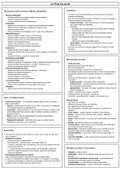Summary
Summary IB Business & Management (HL) - Revision Poster - 3.4 Final Accounts
- Module
- IB Business & Management
- Institution
- IB Business & Management
A detailed revision poster which provides a summary of the IB Business & Management subtopic 3.4 Final Accounts. The document is in a PDF format and the text is unhighlighted to allow for personalisation according to your own colour scheme for your subjects. The use of this revision poster, in addi...
[Show more]



